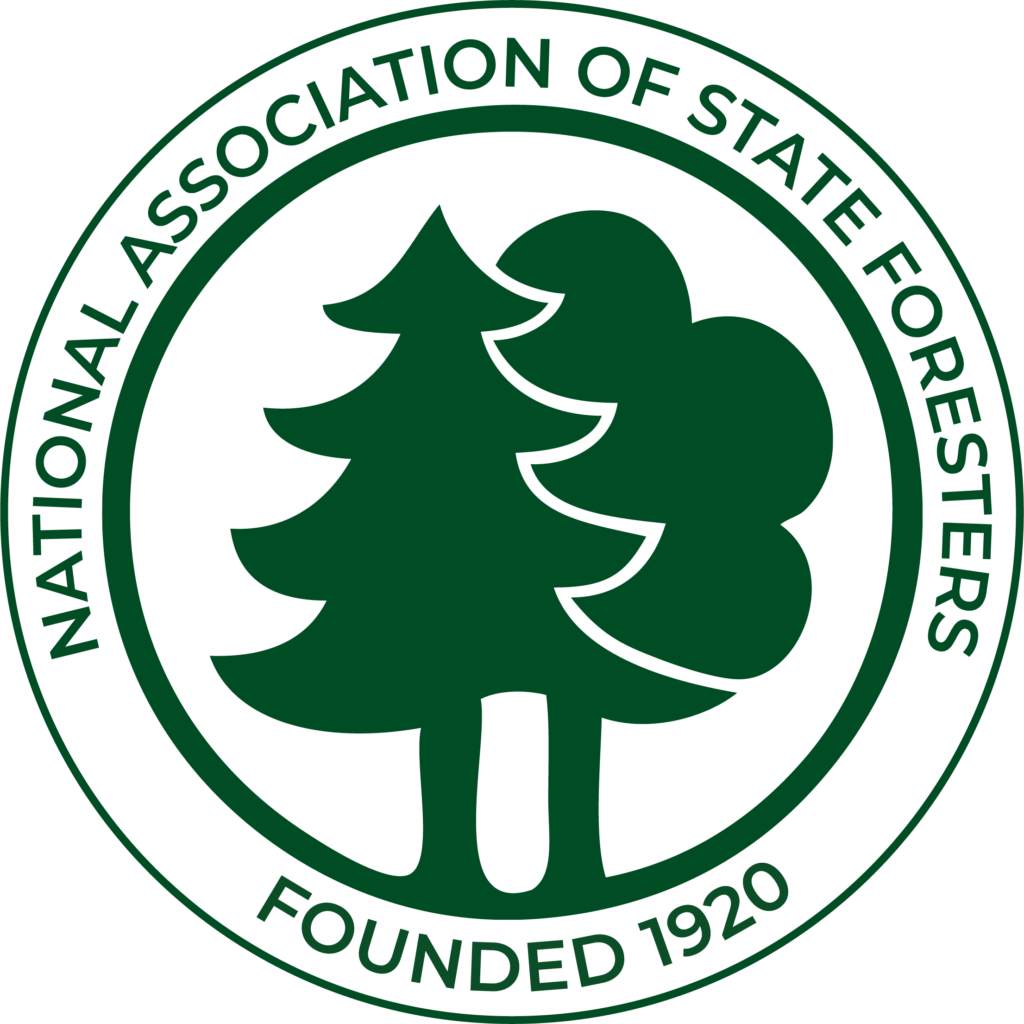 The National Association of State Foresters (NASF) is accepting nominations for its 2025 awards. Only nominations submitted on or before Friday, Aug. 1, through this online form will be considered. Descriptions of the awards, guidelines for selection and a sample nomination are included on the first page of the online form. The awardees will be honored in person and virtually at the 2025 NASF Annual Meeting in Waimea, Hawaii. Continue reading “NASF Accepting Award Nominations”
The National Association of State Foresters (NASF) is accepting nominations for its 2025 awards. Only nominations submitted on or before Friday, Aug. 1, through this online form will be considered. Descriptions of the awards, guidelines for selection and a sample nomination are included on the first page of the online form. The awardees will be honored in person and virtually at the 2025 NASF Annual Meeting in Waimea, Hawaii. Continue reading “NASF Accepting Award Nominations”
Month: July 2025
Upcoming Trainings
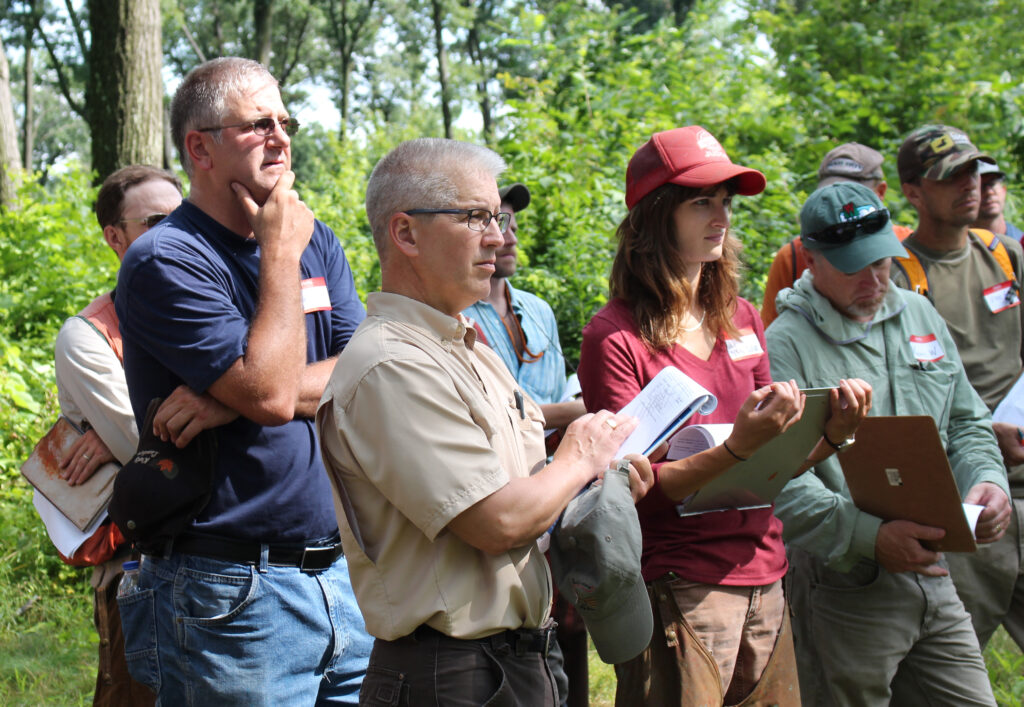 *These training opportunities are provided as an information service only and do not constitute an endorsement from the Wisconsin Department of Natural Resources (DNR).
*These training opportunities are provided as an information service only and do not constitute an endorsement from the Wisconsin Department of Natural Resources (DNR).
See below for information on training topics, including biochar, advanced arboriculture, selecting resilient tree species, The National Urban Tree Canopy Application, invasive species, wildlife and educational resources. Continue reading “Upcoming Trainings”
Armillaria Root Disease: A Fungal Killer
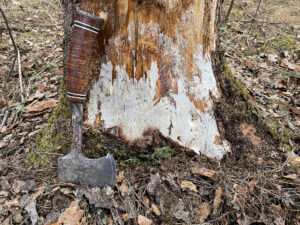
Bark has been removed from a declining white spruce to show the white mycelial mat of Armillaria under the bark. / Photo Credit: Linda Williams, Wisconsin DNR
By Linda Williams, DNR Forest Health Specialist
Linda.Williams@wisconsin.gov or 920-360-0665
Armillaria is a root-rot pathogen that usually lives quietly under the soil. But when trees experience stress, the fungus can attack and colonize the roots of the stressed tree.
Armillaria can infect many different species of trees, and trees of any age or size, but the result for the tree is usually a slow decline and eventual death. Stressors can include drought and flooding, defoliation from insects or diseases or physical damage such as when roots are severed.
New Forest Health Specialists Take To The Woods
By Art Kabelowsky, DNR Outreach and Communications
Arthur.Kabelowsky@wisconsin.gov or 608-335-0167
It’s time for River Mathieu and Tim Shively to put all their education and research to work.
Mathieu and Shively are the newest additions to the Wisconsin Department of Natural Resources (DNR) Forest Health team. Both started on June 30, filling Forest Health Specialist vacancies.
Continue reading “New Forest Health Specialists Take To The Woods”
Gall Causes Bull’s-eye Spots On Maple Leaves
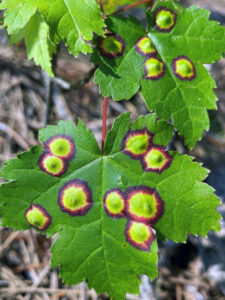
Maple eyespot galls create colorful, concentric patterns on red maple leaves. / Photo Credit: Linda Williams, Wisconsin DNR
By Linda Williams, DNR Forest Health Specialist
Linda.Williams@wisconsin.gov or 920-360-0665
Colorful “bull’s-eye” spots on maple leaves are maple eyespot galls, caused by the tiny ocellate gall midge (Acericecis ocellaris).
The adult midge lays eggs on the underside of the leaves. Once the eggs have hatched, the larvae feed on the leaves. That feeding causes the leaf to develop telltale colorful, concentric circles in that area of the leaf.
Continue reading “Gall Causes Bull’s-eye Spots On Maple Leaves”
Dusky Birch Sawfly Larvae Defoliate Birch Leaves
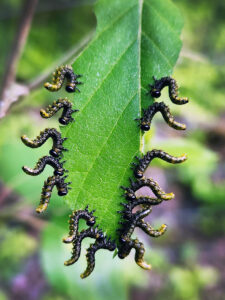
While feeding on a white birch leaf, dusky birch sawfly larvae raise into an S shape when a potential predator is noticed. / Photo Credit: Linda Williams, Wisconsin DNR
By Linda Williams, DNR Forest Health Specialist
Linda.Williams@wisconsin.gov or 920-360-0665
Dusky birch sawfly (Croesus latitarsus) is a native sawfly that feeds on white birch and occasionally river birch and yellow birch. Larvae feed in a group at the edges of birch leaves and abandon part of the midrib before moving on to another leaf.
Defoliation is typically light, with a few dozen leaves per tree being eaten. This defoliation is only problematic on young seedlings with few leaves. There may be two generations of larvae in a year.
Continue reading “Dusky Birch Sawfly Larvae Defoliate Birch Leaves”
Veiled Polypore Fungi Growing On Red Pine Bark
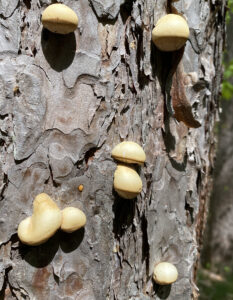
Veiled polypore fungi show as yellow, leathery fruiting bodies on the bark of dead red pine trees. / Photo Credit: Linda Williams, Wisconsin DNR
By Linda Williams, Forest Health Specialist
Linda.Williams@wisconsin.gov or 920-360-0665
You may have seen these leathery, yellow fungi growing on recently dead red pine trees and wondered if they were what killed the tree. The short answer: No, they did not kill the tree.
The veiled polypore (Cryptoporus volvatus) is a decay fungus that grows on the bark of red pine in the year after they die. They can be found anywhere on the trunk of the tree.
Continue reading “Veiled Polypore Fungi Growing On Red Pine Bark”
Heavy Seed Crop And Thin Tops On Maples
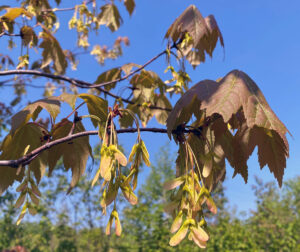
Maple trees producing large seed crops may have off-color leaves that are smaller than normal into early summer. / Photo Credit: Linda Williams, Wisconsin DNR
By Linda Williams, DNR Forest Health Specialist
Linda.Williams@wisconsin.gov or 920-360-0665
Scattered maple trees across parts of the Northwoods have produced heavy seed crops this year.
When trees produce so many seeds, it reduces the amount of energy available for producing leaves. As a result, those leaves can appear smaller and off-color into the summer. With fewer leaves produced, these trees will continue to look very thin throughout this year’s growing season.
Non-Native Caterpillars Attacking Non-Native Euonymus
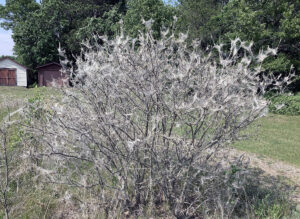
Euonymus caterpillars web branches as they feed on the leaves of Euonymus species. / Photo Credit: Wisconsin DNR
By Michael Hillstrom, DNR Forest Health Specialist
Michael.Hillstrom@wisconsin.gov
Euonymus caterpillars (Yponomeuta cagnagella) made a dramatic appearance in June, webbing and defoliating Euonymus shrubs in several counties.
Multiple species of Euonymus may be attacked, including spindle tree, winged (e.g., burning bush), eastern wahoo, winter creeper and others. Winged euonymus is listed as Restricted in Wisconsin’s invasive species rule NR40.
Continue reading “Non-Native Caterpillars Attacking Non-Native Euonymus”
Tan Tamaracks? It Could Be Larch Casebearer
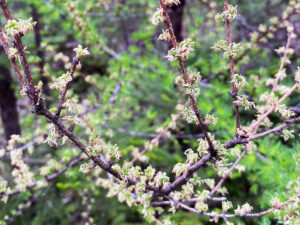
Severe defoliation of a tamarack tree by larch casebearer shows most needles mined out by the larvae. / Photo Credit: Linda Williams, Wisconsin DNR
By Linda Williams, DNR Forest Health Specialist, Woodruff
Linda.Williams@wisconsin.gov or 920-360-0665
If you’ve noticed tamarack trees with tan or light-brown foliage, you’re probably seeing the work of the larch casebearer.
As foliage began to expand this spring, the caterpillars of this invasive moth became active and began to feed. The tiny caterpillars mine out the needles of tamarack and use them as “cases” to protect themselves, hence their name.
Continue reading “Tan Tamaracks? It Could Be Larch Casebearer”
